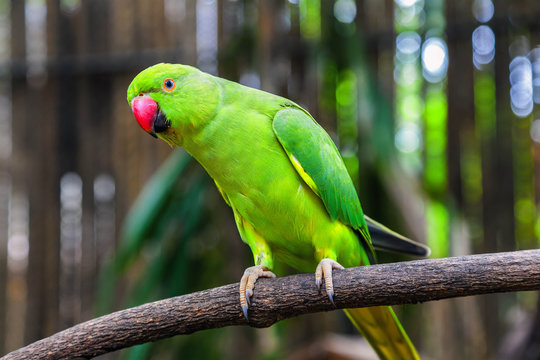Have you ever wondered about the vibrant green parrot and what makes this bird so captivating? These charming creatures are more than just a splash of color in the treetops. They have fascinating behaviors, vivid personalities, and a rich history that has enchanted people for centuries. Let’s dive into the world of the green parrot and discover why they are truly nature’s feathered jewels.
The Alluring Appearance of Green Parrots
One of the first things that catch your eye about green parrots is, naturally, their striking green plumage. This bright coloration isn’t just for show. It serves as excellent camouflage among the lush foliage of their natural habitats. These birds come in various shades of green, often accented by other vibrant colors such as blues, yellows, and reds. For instance, the Green-Winged Macaw, although predominantly green, boasts splashes of red and blue on its wings, making it a living rainbow.
Habitats: Where Do Green Parrots Live?
Green parrots are found in diverse regions around the globe. They thrive in tropical and subtropical environments, ranging from the dense Amazon rainforests to the open woodlands of Australia. These adaptable birds can even be found in urban areas where they coexist harmoniously with human populations. The adaptability of green parrots to different environments is a testament to their resilience and versatility.
Unique Behaviors and Social Structures
Green parrots are known for their intelligent and social nature. They live in flocks, which can range from a small family unit to hundreds of individuals. This social structure is crucial for their survival as it helps them find food and protect each other from predators. Within these flocks, parrots engage in complex communication through a variety of calls and songs. Their vocalizations are not just random noises but rather a sophisticated language that conveys emotions, alerts, and even individual identities.
Green Parrots as Pets: A Bond Like No Other
Many people choose green parrots as pets because of their engaging personalities and striking looks. However, keeping a green parrot is a significant commitment. These birds are highly intelligent and require plenty of mental stimulation and social interaction. They can mimic human speech and sounds, making them entertaining companions. Despite their charms, potential parrot owners should be aware of the bird’s long lifespan and need for consistent care and attention.
Diet and Feeding Habits
In the wild, green parrots have a varied diet that includes fruits, seeds, nuts, and occasional insects. Their strong beaks are well-adapted for cracking open hard nuts and seeds. Parrots also play a vital role in their ecosystems by aiding in seed dispersal, which helps maintain the health and diversity of their habitats. As pets, green parrots require a balanced diet that mimics their natural food sources. Fresh fruits, vegetables, and high-quality pellets are essential for their health.
Reproduction and Lifespan
Green parrots have fascinating reproductive behaviors. During the breeding season, which varies depending on the species and their environment, parrots engage in elaborate courtship displays. These displays often involve vocalizations, feather fluffing, and synchronized movements. Once a pair bonds, they typically mate for life. Female parrots lay eggs in nests built in tree cavities or other secure locations. Both parents share the responsibility of incubating the eggs and feeding the chicks.
In terms of lifespan, green parrots are known for their longevity. Some species can live up to 50 years or more in captivity with proper care. This long lifespan reinforces the idea that owning a parrot is a lifelong commitment.
Conservation Status and Threats
Despite their widespread presence, many species of green parrots face threats from habitat loss, climate change, and the illegal pet trade. Deforestation and urbanization are the primary causes of habitat destruction, which significantly impacts their populations. Conservation efforts are crucial to protect these magnificent birds. Organizations around the world are working to preserve their natural habitats and regulate the pet trade to ensure sustainable populations.
How to Help Protect Green Parrots
There are several ways you can contribute to the conservation of green parrots. Supporting reputable wildlife conservation organizations through donations or volunteer work is a great start. Additionally, if you are considering a green parrot as a pet, make sure to adopt from responsible breeders or rescue organizations. Raising awareness about the plight of these birds and advocating for stronger wildlife protection laws can also make a significant difference.
Fun Facts About Green Parrots
To wrap up our exploration, here are some fun facts about green parrots that highlight their unique characteristics:
- Mimicry Masterminds: Some green parrots, like the African Grey, are renowned for their ability to mimic human speech with incredible accuracy.
- Intelligent Problem-Solvers: These birds are known for their problem-solving skills and can learn to use tools and solve puzzles.
- Long-Lived Companions: With lifespans that can exceed 50 years, green parrots can be lifelong friends.
- Strong Beaks: Their powerful beaks are designed to crack open the toughest nuts and seeds.
- Social Butterflies: Green- parrots thrive in social settings and can develop strong bonds with their human caretakers and other birds.
Conclusion
The green -parrot is more than just a beautiful bird; it is a symbol of nature’s wonder and resilience. These intelligent, social, and vibrant creatures bring joy to many, whether in the wild or as cherished pets. By understanding and appreciating their needs, behaviors, and the challenges they face, we can ensure that green-parrots continue to thrive for generations to come. So, the next time you see a flash of green feathers, take a moment to appreciate the incredible world of the green-parrot.










